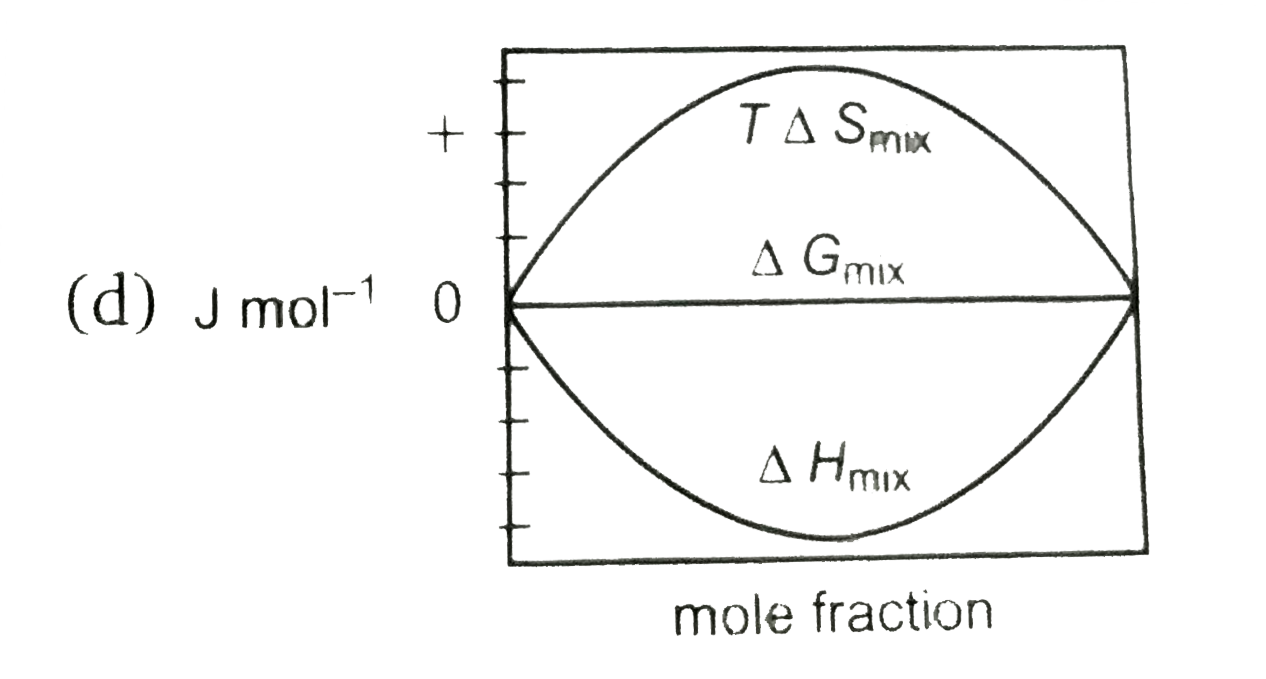Which of the following represents correcty the changes in thermodynamic properties during the formation of 1 mole of an ideal binary solution :




The correct Answer is:c
To solve the question regarding the changes in thermodynamic properties during the formation of 1 mole of an ideal binary solution, we will analyze the changes in Gibbs free energy (ΔG), entropy (ΔS), and enthalpy (ΔH).
1. Understanding the Formation of an Ideal Solution:
- An ideal binary solution is formed when a solute and a solvent are mixed. In this case, we assume that the interactions between the solute and solvent are similar to the interactions between the solute-solute and solvent-solvent.
2. Change in Gibbs Free Energy (ΔG):
- The formation of a solution is generally a spontaneous process. For a spontaneous process, the change in Gibbs free energy (ΔG) is negative.
- Therefore, we can conclude that:
ΔG<0
3. Change in Entropy (ΔS):
- Entropy is a measure of randomness or disorder in a system. When a solute is dissolved in a solvent, the number of particles in the solution increases, leading to greater randomness.
- Thus, the change in entropy (ΔS) is positive:
ΔS>0
4. Change in Enthalpy (ΔH):
- For an ideal solution, it is assumed that there is no heat absorbed or released during the mixing process. This means that the change in enthalpy (ΔH) is zero:
ΔH=0
5. Summary of Thermodynamic Changes:
- Based on the analysis:
- ΔG < 0 (negative)
- ΔS > 0 (positive)
- ΔH = 0 (zero)
6. Identifying the Correct Option:
- Now, we need to find the option that correctly represents these changes. The correct representation should indicate that ΔG is negative, ΔS is positive, and ΔH is zero.
Conclusion:
The correct representation of the changes in thermodynamic properties during the formation of 1 mole of an ideal binary solution is:
- ΔG < 0
- ΔS > 0
- ΔH = 0
- An ideal binary solution is formed when a solute and a solvent are mixed. In this case, we assume that the interactions between the solute and solvent are similar to the interactions between the solute-solute and solvent-solvent.
- The formation of a solution is generally a spontaneous process. For a spontaneous process, the change in Gibbs free energy (ΔG) is negative.
- Therefore, we can conclude that:
ΔG<0
- Entropy is a measure of randomness or disorder in a system. When a solute is dissolved in a solvent, the number of particles in the solution increases, leading to greater randomness.
- Thus, the change in entropy (ΔS) is positive:
ΔS>0
- For an ideal solution, it is assumed that there is no heat absorbed or released during the mixing process. This means that the change in enthalpy (ΔH) is zero:
ΔH=0
- Based on the analysis:
- ΔG < 0 (negative)
- ΔS > 0 (positive)
- ΔH = 0 (zero)
- Now, we need to find the option that correctly represents these changes. The correct representation should indicate that ΔG is negative, ΔS is positive, and ΔH is zero.
The correct representation of the changes in thermodynamic properties during the formation of 1 mole of an ideal binary solution is:
- ΔG < 0
- ΔS > 0
- ΔH = 0
Topper's Solved these Questions
- DILUTE SOLUTIONBOOK - NARENDRA AWASTHI ENGLISHCHAPTER - DILUTE SOLUTIONEXERCISE - leval-03
23 Videos
- DILUTE SOLUTIONBOOK - NARENDRA AWASTHI ENGLISHCHAPTER - DILUTE SOLUTIONEXERCISE - leval-03
23 Videos
- CHEMICAL EQUILIBRIUMBOOK - NARENDRA AWASTHI ENGLISHCHAPTER - CHEMICAL EQUILIBRIUMEXERCISE - Match the column
1 Videos
- ELECTROCHEMISTRYBOOK - NARENDRA AWASTHI ENGLISHCHAPTER - ELECTROCHEMISTRYEXERCISE - Subjective problems
14 Videos
Similar Questions
Which of the following represent the correct sequence of indicated property ? .
View SolutionWhich of the following represents the correct order of the properties inidicated?
View SolutionWhich of the following expression represents, the first law of thermodynamics ?
View SolutionWhich of the following represents the incoorect order of the properties indicated?
View SolutionWhich of the following is correct for an ideal solution?
View SolutionWhich of the following does not represent the correct order of the properties indicated?
View SolutionWhich of the following does not represent the correct order of the properties indicated ?
View SolutionWhich of the following represents the incorrect order of properties ?
View SolutionWhich of the following plots represents an ideal binary mixture?
View SolutionWhich of the following reaction represents the correct product formation?
View Solution
